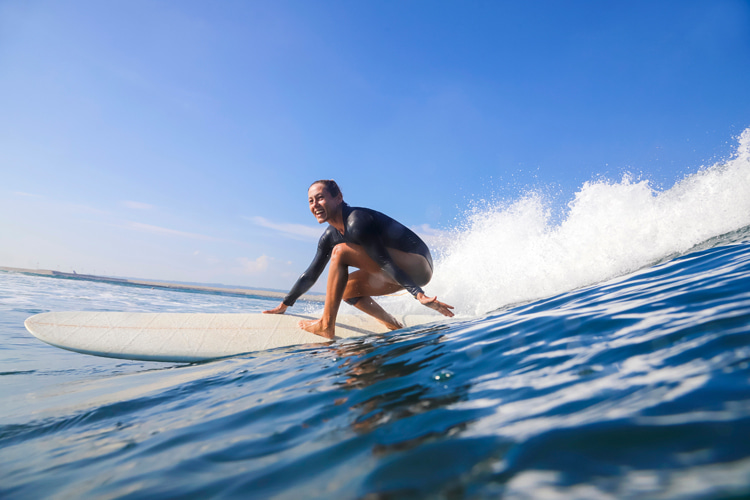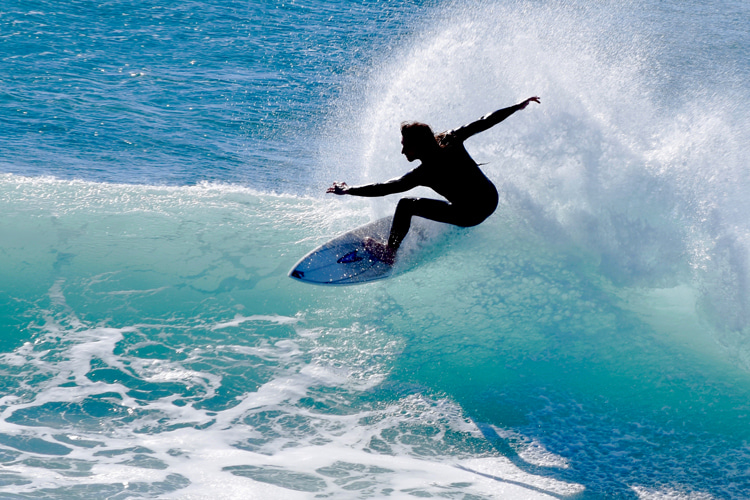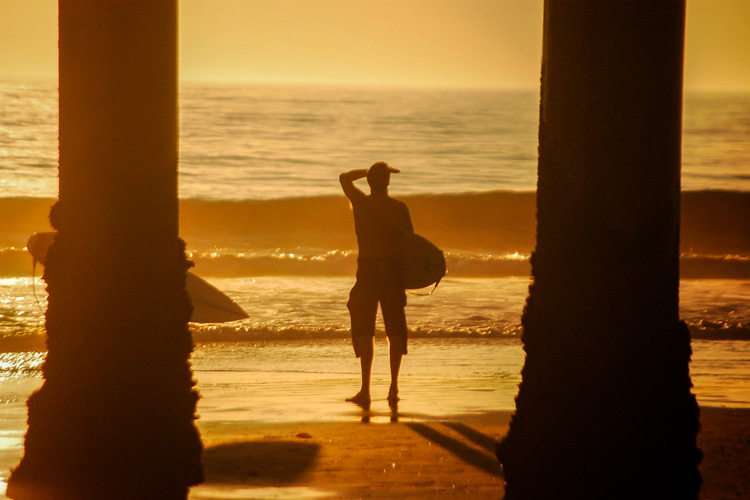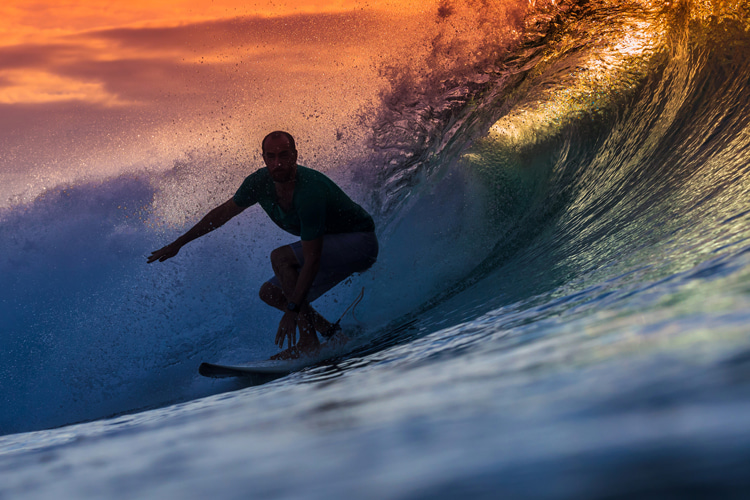If I were asked to select one single aspect of surfing that stands out above all others, I would undoubtedly select the permanent increase that the neophyte surfer can expect in health and fitness.
The people responsible for President Kennedy's exercise campaign could well consider a resolution to get everybody in this country to take up some form of surfing.
Perhaps we could construct artificial wave producers for inland lakes, and we could subsidize paddleboard races on rivers and canals.
After a few weeks of paddling, the most seedy-looking children would start to fill out like Tarzans.
As a sport for boys, surfing also builds courage and lightning-quick reactions, together with an ability to look after themselves in tight spots - the sort of qualities on which a nation's future depends
It was not for nothing that Kamehamaha's bravest warriors were those who excelled at surfing and all the other great Hawaiian sports.
For girls, surfing supplies the kind of grace and physical development more normally associated with ballerinas or professional dancers, and is there ever enough of this commodity around?
Moreover, the dull routine of learning and practice associated with dancing is not required.
Surfing is never boring.
If I could pick out one suggestion or watchword for present and future surfers to live by, it would be an increase in courtesy both to the public and to other users of the beaches.
The best way to overcome the bad publicity we get from the "ho-dads" is for other surfers to be exceptionally polite, to help swimmers in trouble, to collect loose boards, and to return them to their owners.
It is also a good idea to make sure the surfer is all right when you see a board washed in.
Larry Segedin would probably not be here today if it hadn't been for the consideration and presence-of-mind of a nameless but well-remembered Hawaiian surfer.

The Downsides
If one praises surfing for its health-improving properties, one must, in fairness, discuss the negative side of the sport - the degrees of danger and the accident potential which may be expected.
Unfortunately, surfing accidents are sufficiently spectacular that they are written up in the newspapers with all the sensationalism usually reserved for airplane crashes.
It is simply not true, as I have seen it claimed, that there are numerous surfing deaths or serious injuries.
There are incredibly few when you consider the treacherous waters often frequented by surfers.
In fact, the average number of deaths from surfing is less than one a year, and this is usually caused by veteran surfers putting their luck in traction - by speeding under piers, for instance, or surfing big wave beaches in storms.
Occasionally, a rank beginner will surf the 20-foot beach break at Makaha in an inner tube and get paralyzed, or someone will get hit by a flying board.
As has already been pointed out, shark attacks, which receive so much publicity when they come, are extremely rare and can be ignored in America.
The odds are so great against them, although occasionally, in Australia, sharks can be a menace.
But I mustn't paint too rosy a picture since surfing is certainly not for sissies.
Most regular surfers can expect to endure an accident of some kind at least annually and sometimes as often as once a month.
These are fortunately minor, as a rule, such as getting a smart rap from a vacant surfboard or enjoying a brief encounter with a Portuguese man o' war; in areas of coral, the odd scraping session on the lower limbs is hard to avoid.
Most of these occurrences can be uncomfortable, but usually, they need not be serious.

A Healthy Addiction
You will find that all good surfers keep a weather eye open to minimize such situations when they arise.
There is one chronic danger to the surfer, which is rarely mentioned but should be studiously watched, and that is the time it takes.
This may seem to be a truism, but it can turn into the greatest accident of all, not because you couldn't get by with an hour a day - you could - but the chances are you won't, and surfing will take hold of you like dope, dominoes or centrifugal bumble puppy, and you will become an addict with Surfers' Anonymous as your last best hope for a normal life.
I found that during the two years of my more or less intensive surfing experience in Hawaii, my income ground slowly but steadily to a halt.
My health, however, increased at least 200 percent, so there are apparent compensations for those who end up poor but happy.
One of the things that an outsider observing the surfing scene finds most striking is the concern that most good surfers have for the reasons why they surf.
These are discussed in a personal way in my book "Surfing in Hawaii."
The movie "Gidget," which was such a tremendous box-office success, was based on actual facts, and characters such as Kahuna are not uncommon among surfing groups.
The Hawaiian Kahunas, or high priests of surfing, instructed the young and spoke to the waves.
As John Lawrence notes, many surfers still talk to the water while awaiting the waves and will fast for days (or rather go without eating) when the surf is up.
Veteran surfers will literally live off the land to reduce their surfing time to a minimum.
The famous Gene "Tarzan" Smith is now a hermit in Hawaii and no longer recognizes his friends.
Many surfers work only to get enough money to surf for as long a period as possible; they then bunk up in an old station wagon near Makaha or Sunset Beach for the rest of the year, having entrusted their tender carcasses to the airline known as the Surfers' Express ($75 one way) to get to the Islands.
Still, other surfers, some of them graduates of reputable universities, affect esoteric overtones and fancy themselves as surfing beatniks, although even those with little conventional education can keep their end up surprisingly well in a philosophical entanglement.
Among the full-time surfers, some manage to get jobs as lifeguards or are connected in one way or another with surfboard-building firms, although a few get by in what one can only term a mysterious fashion.
They live like gentlemen and surf whenever they please, with no conspicuous signs of regular income.

Balancing Waves and Work
But who can begrudge success to people we would all like to emulate?
From the genuine gentleman surfer to the "gentleman" who steals to keep alive is but a short step.
Every generation that is not a war generation has its section of have-nots who are looking for self-expression.
When there were only a few hundred surfers, the ho-dads were barely noticed, but the proportion seems constant; so that when taken from a few hundred thousand, it may pose a serious problem, an issue which will need solving with a firm hand to keep authorities from closing further beaches to the entire surfing community, merely because of the antics of the faceless few.
Fortunately, the average surfer is a healthy, loose-limbed, clear-eyed teenager who surfs because he enjoys it.
After a few years, his surfing days are likely to terminate abruptly due to the demands of a job or of college studies.
During this time, he too is inclined to musing with a far-off look in his eye and to wondering "the why" of the lure of the waves.
And in years to come, he may ponder his life as a "square" with two cars in his suburban garage, while in his mind's eye, he pictures himself lounging complacently in the blissful Eden of a distant tropic beach, in company with a ukulele, a hula dancer, and a grove of coconut palms.
And to complete this dazzling scene, the great white lines of the breakers come roaring in over the reef, striking that never-forgotten contrast with the brilliant blue of the sea.
Words by Desmond Muirhead | Golf Course Designer and Author of the Book "Surfing in Hawaii" (1962)
Epilogue of "Surfing in Hawaii" was published under the authorization of Rosemary J. Muirhead, one of the three daughters of Desmond Muirhead
